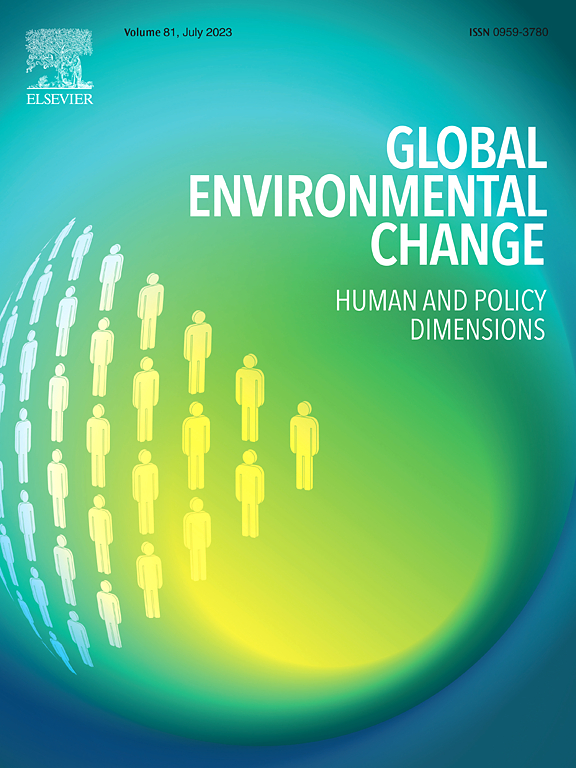人人享有美好生活所需的劳动力和资源
IF 9.1
1区 环境科学与生态学
Q1 ENVIRONMENTAL SCIENCES
引用次数: 0
摘要
我们使用多区域投入产出分析来计算满足所有人基本需求所需的有偿劳动、能源、排放和材料使用。我们以英国为例,计算了两种不同的低消费情景:(1)“体面生活”情景,只包括基本必需品;(2)“美好生活”情景,基于英国居民所要求的最低生活标准。我们将由此产生的足迹与英国目前的足迹、美国、中国、印度的足迹以及全球平均水平进行比较。劳动力足迹按部门、技能水平和原籍地区分类。我们发现,这两种低消费方案都不是为所有人提供美好生活的现实途径。虽然体面的生活情景只需要每周工作18小时,并且以人均为基础,每年消耗35吉焦的能源,4.0吨的排放和5.5吨的材料,但它无法满足基本需求。美好生活的情景包含了这些需求,但需要每周工作46小时,能源消耗73吉焦,排放量7.5吨,人均材料消耗13.2吨。这两种情况都代表了英国目前每周65小时的劳动力足迹的大幅减少,英国只能通过从其他国家进口相当一部分劳动力来维持。我们的结论是,将消费限制在基本需求的水平不足以实现可持续性。还需要对供应系统进行重大更改。本文章由计算机程序翻译,如有差异,请以英文原文为准。

The labour and resource use requirements of a good life for all
We use multi-regional input–output analysis to calculate the paid labour, energy, emissions, and material use required to provide basic needs for all people. We calculate two different low-consumption scenarios, using the UK as a case study: (1) a “decent living” scenario, which includes only the bare necessities, and (2) a “good life” scenario, based on the minimum living standards demanded by UK residents. We compare the resulting footprints to the current footprint of the UK, and to the footprints of the US, China, India, and a global average. Labour footprints are disaggregated by sector, skill level, and region of origin.
We find that neither low-consumption scenario provides a realistic path to providing a good life for all. While the decent living scenario would require only an 18-hour working week, and on a per capita basis, 35 GJ of energy use, 4.0 tonnes of emissions, and 5.5 tonnes of materials per year, it fails to provide essential needs. The good life scenario encompasses these needs, but would require a 46-hour working week, 73 GJ of energy use, 7.5 tonnes of emissions, and 13.2 tonnes of materials per capita. Both scenarios represent substantial reductions from the UK’s current labour footprint of 65 hours per week, which the UK is only able to sustain by importing a substantial portion of its labour from other countries. We conclude that limiting consumption to the level of basic needs is not enough to achieve sustainability. Substantial changes to provisioning systems are also required.
求助全文
通过发布文献求助,成功后即可免费获取论文全文。
去求助
来源期刊

Global Environmental Change
环境科学-环境科学
CiteScore
18.20
自引率
2.20%
发文量
146
审稿时长
12 months
期刊介绍:
Global Environmental Change is a prestigious international journal that publishes articles of high quality, both theoretically and empirically rigorous. The journal aims to contribute to the understanding of global environmental change from the perspectives of human and policy dimensions. Specifically, it considers global environmental change as the result of processes occurring at the local level, but with wide-ranging impacts on various spatial, temporal, and socio-political scales.
In terms of content, the journal seeks articles with a strong social science component. This includes research that examines the societal drivers and consequences of environmental change, as well as social and policy processes that aim to address these challenges. While the journal covers a broad range of topics, including biodiversity and ecosystem services, climate, coasts, food systems, land use and land cover, oceans, urban areas, and water resources, it also welcomes contributions that investigate the drivers, consequences, and management of other areas affected by environmental change.
Overall, Global Environmental Change encourages research that deepens our understanding of the complex interactions between human activities and the environment, with the goal of informing policy and decision-making.
 求助内容:
求助内容: 应助结果提醒方式:
应助结果提醒方式:


